An oil rig is a massive structure used to drill oil (Check Rig Components) in offshore and onshore conditions. These engineering marvels weigh thousands of tons and are loaded with many functionalities. Drilling rigs come in different sizes and types; some are more fascinating than others. Remember that the biggest oil rigs take billions of dollars and years to build. Various types of drilling rigs are used; some are fixed to the seabed, while others float on the surface.
Without oil and gas production platforms (Platform Rig), energy companies cannot fulfill the oil demand at economical prices (Crude Oil Prices History) with rig workers‘ jobs. Let’s delve into the universe of the five biggest oil rigs;
| Rig Name | Loc. | Cost – Billion Dollar | Weight- Ton | Number Of Wells | Dimensions – meter | Daily Production |
| Berkut | Russia | 12 | 200,000 | 45 | 105 x 60 x 144 | 12,000 Ton oil |
| Perdido | Gulf of Mexico | 3 | 55,000 | 35 | – | At the peak: 100,000 barrels of oil equivalent a day, and 200 million cubic feet of gas. |
| Petronius | Gulf of Mexico | 0.5 | 50,500 | 21 | Deck: 64 x 43 x 18.3 | 50,000 Barrels of Oil Equivalent + 70 MCF Gas |
Berkut | The Massive Oil Rig
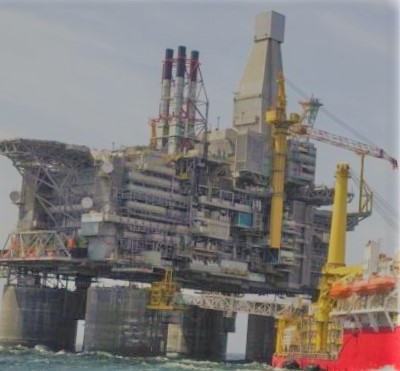
Golden Eagle or Berkut Drilling rig is the biggest oil rig in the world. This offshore drilling rig is located on the Russian Pacific Coast, north of Japan, in the sea of Okhotsk. According to Reuters, the Berkut oil rig is a part of the Sakhalin-1 development and was built by ExxonMobil, Rosneft, and other partners.
Berkut was one of the most challenging and expensive projects undertaken by significant oil and gas companies that spent over 12 billion dollars. The Berkut oil platform can produce 12,000 tons daily and 4.5 million tons of oil yearly.
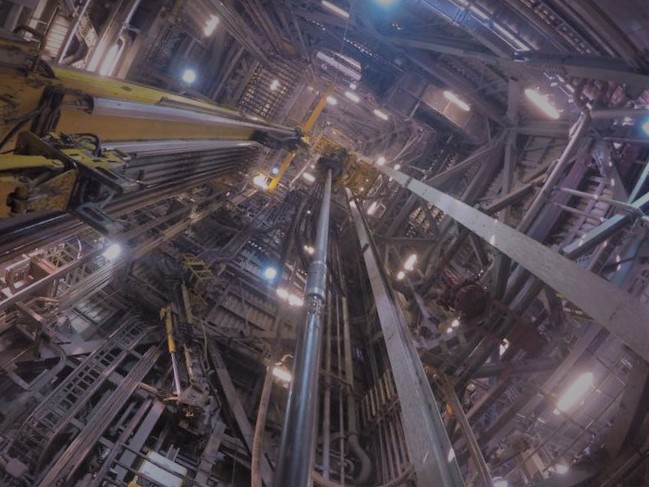
Significant Features of Berkut, the biggest Oil Rig
- The length of the platform is 105 meters, the width is 60 meters, and the height with the base is 144 meters.
- This massive structure weights over 200,000 tons and is considered the heaviest topside ever floated on the ocean’s surface.
- A significant feature of the Berkut oil platform is, having a gravity-based structure. It adapts an advanced earthquake protection system that withstands excitation of magnitude 9.
- The platform is fixed to the seabed. GBS construction took 52,000m3 of concrete alone.
- Berkut has the world’s most powerful top drive of the drilling rigs with a top drive torque of 142 kilonewtons per meter and lifting power of the machine of 1150 tons.
- This biggest oil rig in the world can also withstand subarctic conditions, including temperatures up to -44 degrees and the pressure of over 6 ft of ice.
- It can withstand waves with a height of 16 to 20 meters and withstand winds blowing at a speed of 120 kilometers per hour.
- The Berkut platform is equipped with a mobile floating drilling rig that can drill wells throughout the year, operating up to seven kilometers from the platform.
It involved many revolutionary methods, broke world records, and is still regarded as the biggest oil rig in the world.
Perdido | The Second Biggest Oil Rig
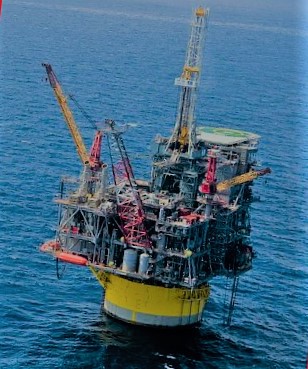
The Perdido rig is the world’s deepest and second-biggest drilling rig located in the Gulf of Mexico, known for its richest discovery in crude oil. Standing at around 1800 ft, the drill floor covers an area of over 280,000 sq. ft. The Perdido rig is owned by Shell companies, BP, and Chevron.
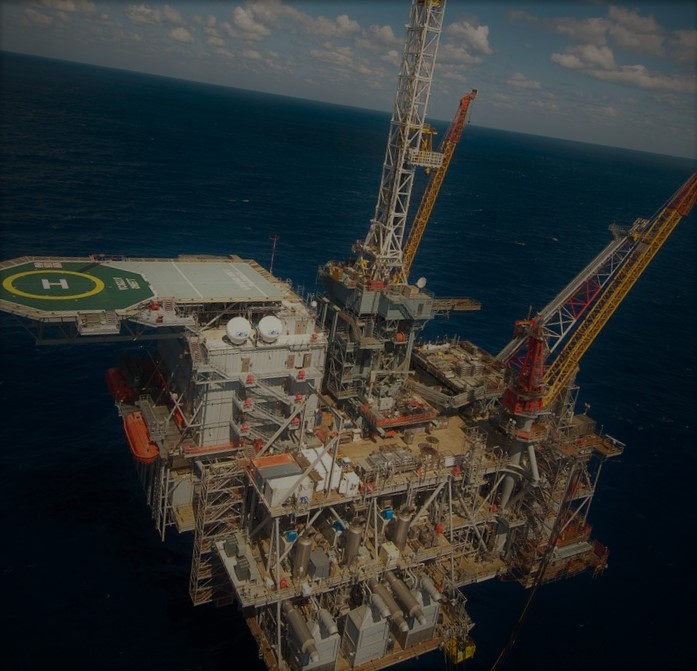
According to resources, the topsides and spars were constructed separately and transported 13,200 to Texas. The platform took five years to complete and over three billion dollars to build with various rig move operations. Over 12,500 experts were involved in constructing the world’s deepest oil rig. Perdido drilling rig has a capacity of 100,000 barrels of oil per day.
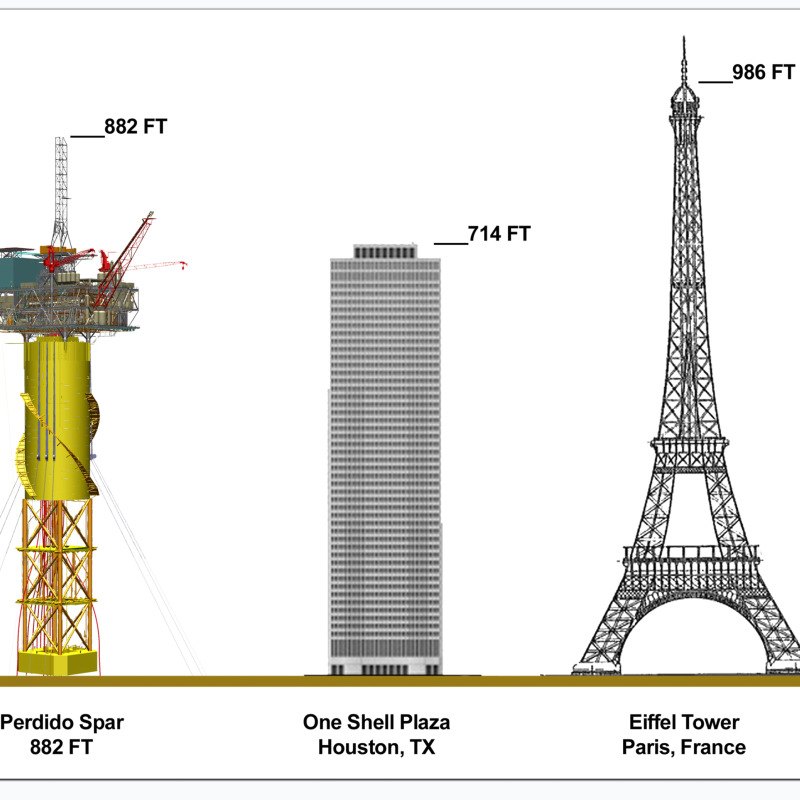
Significant features of Perdido Oil Rig
- It has a total depth of 2450 meters. Only 267m of the Perdido rig lies above the water level.
- The platform employs 172 employees.
- It’s a spar-kind floating rig using a large-diameter vertical calendar much denser than water to lower the center of gravity.
- The outer diameter of the cylindrical part is 36 meters. This element ensures the buoyancy of the platform, including storage tanks for produced hydrocarbons. The total height of the leg is 169 m, and the weight is 20 tons.
- Weight with loaded ballast – 1.2 million tons
- The unique and classic spar design was constructed by Technip company in Finland.
- The advanced technology applied to this rig can handle external pressure, low temperature, uneven sea floor terrain, and water depth.
- The platform has three decks or topsides that house oil and gas processing facilities, a drilling rig, and workers’ accommodation.
- Perdido produces oil from 35 subsea wells, 22 under the spar and 13 wells located eight miles west of the platform. They are connected by a 44-kilometer (27-mile) pipeline network on the ocean floor and a collector below the platform, where the oil is pumped up five flexible pipes called risers.
- The biggest oil rig also included three topsides that support the processing units of oil and gas.
- Computer-guided laser technology is added to the oil rig to ensure precision measurements.
- The Perdido heliport can accommodate two Sikorsky S-92 helicopters , each carrying 19 passengers.
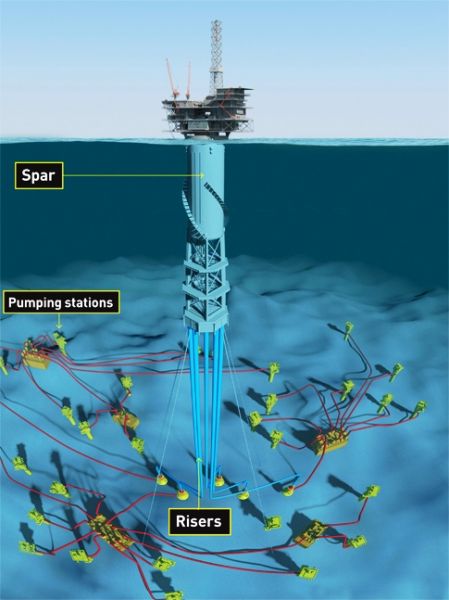
The first commercial production was achieved from the Perdido rig in 2010 by Shell oil company in the US Gulf of Mexico.
Petronius Oil Rig
This complaint tower structure is 210 km southeast of New Orleans, in the Gulf of Mexico. The Petronius oil rig has a total height of 640 meters. It was the largest free-standing structure in the world, but later, Burj Khalifa surpassed this record in the initial few years of the current century. The project took ten years to construct and over 1 billion dollars to build.
Petronius delivered its first oil in 2000. The ingenious design of Petronius has a maximum capacity of 60,000 barrels of oil per day.
Significant features of Petronius Oil Rig
- Its central part, 535 m, is underwater, and only 75 m is above the sea.
- The third largest oil rig in the world weighs 43,000 tons, standing at 1870 ft.
- This compliant tower can sway up to 2 percent of its height. Generally, a maximum of 0.5% of sway is allowed in buildings to ensure the comfort of occupants.
- The deck of the platform has dimensions 64x43x18.3 m, 21 wells are installed on it,
- It produces approximately 3,000 m3 of oil and 2,000,000 m3 of natural gas daily.
- Petronius’s overall design can blend and flex with forces of wind, current, and waves.
- The structure owns two levels weighing over 8000 tons. It includes all the essential equipment, operation rooms, rooms for the workers, and a drilling rig with 21 wells.
- An interesting fact is that due to its height, sometimes with strong winds and storms, the surface of the platform can deviate by as much as 2% of its height. Such abilities make this structure much more flexible and stable than tall structures above ground.
Chevron Corporation owns Petronius.
Hibernia is One of The Biggest Oil Rigs
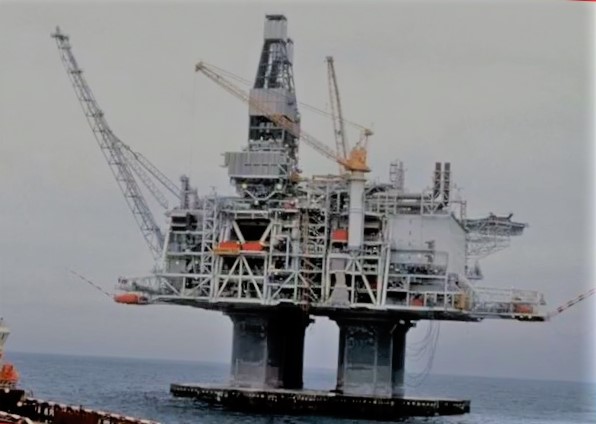
Hibernia is the world’s first gravity-based and iceberg resistance rig. It is located 315km east of Newfoundland, Canada, with 80 meters of depth below the sea. The height of this gigantic structure is 1100 ft covering a drill floor of 220,000 sq ft. It’s another biggest oil rig that took 15 years to complete and over five billion dollars to build. This massive oil rig is significantly designed to get 220,000 barrels of crude oil daily with the help of various types of drilling fluids.
Significant features of Hibernia Oil Rig
- Hibernia is one of the biggest oil rigs in the world. It’s capable of resisting the harmful impacts of icebergs and sea ice for smooth operation.
- The rig can withstand a six-million-ton iceberg; that’s quite amazing.
- Advanced oil recovery technology is used to support the Hibernia rig.
- The value of the oil produced up to a 2016 was more than $65 billion.
Hibernia rig is owned by Suncor Energy, Chevron, and Exxon Mobil companies.
Olympus Drilling Rig
Olympus, also known as Mars B, is 845 meters high in the Gulf of Mexico. It’s the world’s fifth biggest oil rig, owned by Shell company. Over 25,000 workers were involved in the construction of this gigantic structure. Still, there are many drilling rig vacancies out there.
The purpose of installing the Mars B platform was to expand the lifespan of oilfields until 2050. Olympus rig can process 10,000 tons of oil per day. It features 24 well slots equipped with a helipad and drilling rig.
Significant features of Olympus Oil Rig
- Olympus is Shell’s seventh deep-water floating rig using ocean-bottom seismic technology.
- The rig comprised four tension legs along with 16-lined caissons.
The hulk of the rig was built in South Korea, and the first oil production from the Olympus began in 2014.
Conclusion
Oil rigs are used to produce oil located closed to the oil fields. The overall size of the oil rig has a significant impact on its drilling capabilities. The biggest oil rigs in the world are owned by multiple key players in the oil & gas sector.
Keep visiting to know more of the exciting marvels of the Oil Industry.